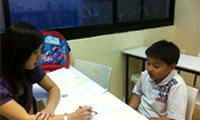-
We believe that initial teaching should begin with the learner’s existing knowledge and then develop further.
Who is guiding the Teaching Methodology at The Language Learner?
-

Dr Sepalika is the Director of the Language Learner. She was a registered lecturer with the Ministry of Education (MOE) & the Ministry of Community Development, Youth and Sports (MCYS) Singapore

-
Our philosophy at the Language Learner is to facilitate individualised learning.
We assist students in creating achievable learning goals that are consistent. Then, help to develop their existing knowledge to a higher level to acquire their future aspirations.
-
What is the Philosophy behind our Teaching?
We follow the Singapore English Language school syllabus approved by the MOE. We continually revise and update our syllabus to keep abreast of new guidelines set by the MOE.
-
According to Information Processing Theory when what is being taught is relevant to the student, he or she is more likely to retain information and participate effortlessly in the learning experience.
-
What is meant by Student-Centered Learning?


-
The Student-Centered learning approach at the Language Learner is based on the principals of key educational researchers as well as childhood theorists including John Dewey, Jean Piaget, and Lev Vygotsky. According to them learning requires the active, constructive involvement of the learner.
As Howard Gardner proved through his research, children learn in many different ways, and no one method is suited for all. So we believe in individualised teaching.
-
How do we facilitate one to one sessions in a classroom situation?
-

